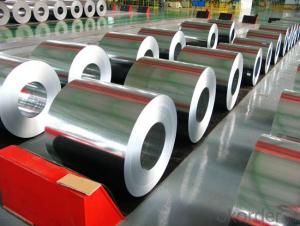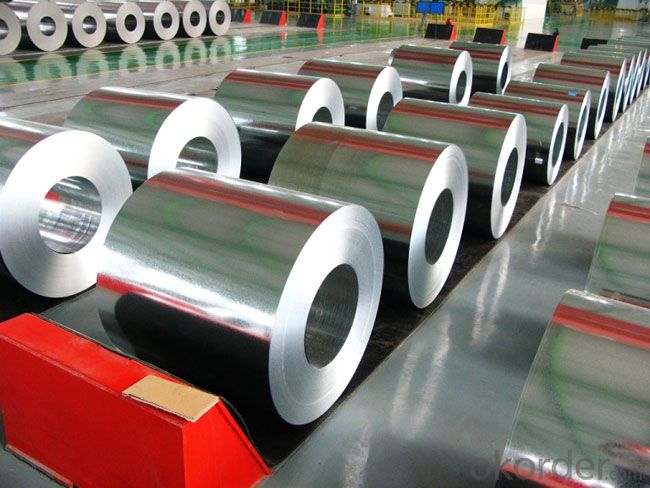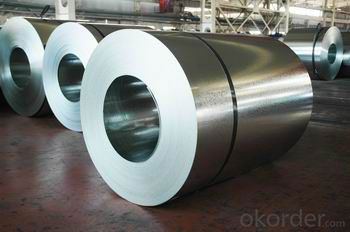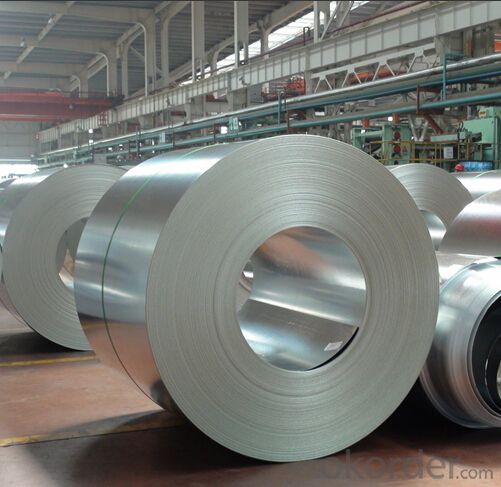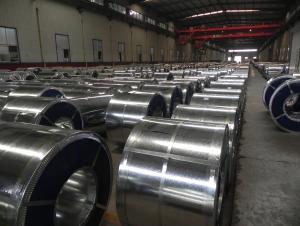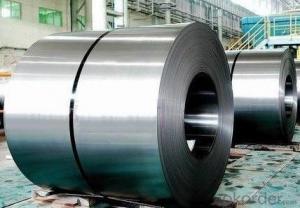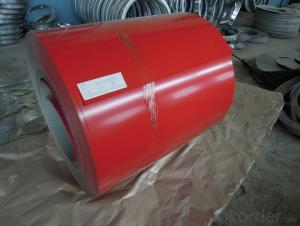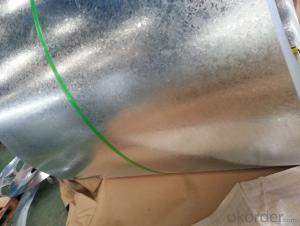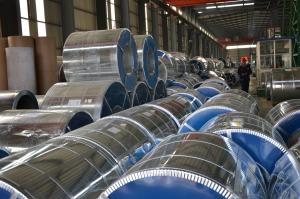Galvanized STEEL Coils
- Loading Port:
- China Main Port
- Payment Terms:
- TT OR LC
- Min Order Qty:
- -
- Supply Capability:
- -
OKorder Service Pledge
OKorder Financial Service
You Might Also Like
Steel Specification:
Thickness: 0.2-3.0mm
Width: 600-1500mm
Coating :
Zinc Coating Weight Symbol | AZ 06 | AZ08 | AZ 13 | AZ 12 | AZ 18 | AZ 20 | AZ 22 | AZ 26 | AZ 27 |
Zinc Coating Thickness (mm) | 0.013 | 0.017 | 0.021 | 0.026 | 0.034 | 0.040 | 0.043 | 0.049 | 0.054 |
Weight g/㎡ (both sides) | 90 | 120 | 125 | 183 | 244 | 285 | 305 | 345 | 381 |
ASTM A 525 | G-30 |
| G-40 | G-60 |
| G-90 |
|
| G-115 |
Tolerance for thickness,width,flatness and so on conform to the requirements of JIS G3302 or ASTM A653M/924M
Coil ID can be either 508mm or 610mm, maximum coil OD is 2000mm
The speicfication of ASTM Such as A653m,A924 M and so on have been updated to the latest revisions
Excellent film adhesion
The coating layer is manufactured with fine porous surfaces so as to be high in surface vitality and be very excellent in film adhesion without phosphate treatment.
Excellent corrosion resistance
The surface layer is finer and harder than electrically galvanized steel sheets by using a hot-dip coating method so as to be excellent in white rust resistance at constant temperature and humidity as well as in red rust resistance. Especially, the adhesion with paint is good so as to be very excellent in paint corrosion resistance.
Excellent powdering resistance
This is manufactured in a short time heating and long time heat treatment method so as to be very excellent in powdering resistance.
Diverse mechanical property and high formability
The passing length of heating, crack and cooling zone of furnace before coating is made longer than the existing equipment so as to secure diverse mechanical property and high formability so that diverse desires of consumers can be satisfied.
Beautiful appearance
The flatness equal to the cold rolled steel sheet was realized by completely removing unevenness in the surface layer occurring during iron-zinc alloy using a temper rolling mill of high pressure load ratio after coating. Besides, this has no spangle and has a white gray color similar to EGI so as to be very beautiful in appearance
Corrosion resistance
The improved corrosion resistance of 55% AI-Zn alloy-coated steel coils is derived from the unique combination of the barrier protection of the aluminum and the sacrificial protection of the zinc. The formation of an insoluble aluminum oxide layer provides the barrier protection while the zinc provides a sacrificial protection at cut edges, scratches and areas of coating damage. Outdoor exposure testing of 55% AI-Zn alloy-coated steel onus has been conducted for over 20 years in various atmospheric environments. This testing also demonstrated a superior cut edge protection of 55% AI-Zn alloy-coated steel sheet than the galvanized steel sheet.
Heat resistance
Similar to the aluminum coated steel sheet that can resist high temperature oxidation, 55% AI-Zn alloy-coated steel sheet demonstrates better resistance to high temperature than the galvanized steel sheet.Benlog 55% AI-Zn alloy-coated steel sheet can be used in temperatures up to 315ºC.
Heat transmission and reflectivity
55% AI-Zn alloy-coated steel coil has a high reflectivity value making it an effective barrier against heat.
Surface Treatment:
Chromate treatment,Oiled or Anti-finger print
Surface Finished:
REGULAR SPANGLE:
Regular spangle is also called normal spangle which is naturally formed without any additional treatment during galvanizing.
MINI SPANGLE:
The spangle is restrained and formed as mini spangle by reducing the lead content in the zinc liquid or by blowing the zinc powder from the equipment installed on the zinc pot.
EXTRA SMOOTH:
The mini spangle is further skin-passed to produce the extra smooth surface
Application:
BUILDING & CONSTRUCTION
Floor decks, ceilings, verandas, rolling doors, warehouse, partitions, sheds, gutters, wall, underground piping, sashes, beams, fences, scaffolding, indoor decorations, ducts, ventilating pipes, steel frames and cable trays.
ELECTRICAL APPLIANCES
Freezers, video recorder cases, motor cases, lighting fittings, water heaters, washing machines, refrigerators, stoves, air conditioners, dehumidifiers, fluorescent light housings, electrical heaters, toasters, microwave oven enclosures and switch boxes.
TRANSPORTATION
Containers, under body panels, bus & truck body panels, fuel tanks, noise screens, highway signs, air cleaners, conveyor systems and guard rails.
AGRICULTURAL EQUIPMENT
Barns, drying machines, animal houses, hoppers, irrigation systems, greenhouses, water tanks, sheds, silos, agricultural implements and feeders.
FURNITURE & OTHERS
Vending machines, drums, cans, pails, sauna inner parts, chimney pipes, entertainment machines, solar collectors, office equipment, steel furniture, tool boxes, garages and waste bins.
COMPUTER'S APPLIANCES
Computer shells and communication instruments。
- Q: What are the dimensions of a typical steel coil?
- The dimensions of a typical steel coil vary based on its intended use and manufacturer. However, a common range for the inner diameter is between 508 to 610 millimeters (20 to 24 inches), while the outer diameter can range from 1,200 to 2,000 millimeters (47 to 79 inches). The width of a steel coil can range from around 600 to 2,000 millimeters (24 to 79 inches), and the weight can vary from a few hundred kilograms to several metric tons.
- Q: What are the different types of welding used for steel coils?
- Steel coil fabrication involves the utilization of various welding techniques, each catered to specific requirements and applications. Here, we present some commonly employed welding methods for steel coil fabrication: 1. Stick welding, also known as Shielded Metal Arc Welding (SMAW), utilizes a flux-coated electrode and an electric current to generate an arc between the electrode and the base material. SMAW is a versatile and extensively used technique suitable for a range of steel coil applications. 2. Gas Metal Arc Welding (GMAW), also referred to as MIG (Metal Inert Gas) welding, employs a continuous wire electrode and a shielding gas to safeguard the weld pool against atmospheric contamination. GMAW is renowned for its high welding speed and ease of automation, making it a favored choice for steel coil manufacturing. 3. Flux-Cored Arc Welding (FCAW) shares similarities with GMAW, but employs a tubular electrode with flux inside. The flux serves as both the shielding gas and added alloying elements, resulting in enhanced efficiency and weld quality. FCAW is often employed for high-speed welding applications in steel coil fabrication. 4. Gas Tungsten Arc Welding (GTAW), also known as TIG (Tungsten Inert Gas) welding, employs a non-consumable tungsten electrode and an inert gas, typically argon, to protect the weld area. GTAW delivers high-quality, precise welds with exceptional control over heat input, rendering it suitable for thin steel coil materials and critical welding scenarios. 5. Submerged Arc Welding (SAW) involves the use of a continuously fed wire electrode and a granular flux that covers the weld area. The arc is submerged beneath the flux, providing excellent protection and minimizing the need for post-weld cleaning. SAW is commonly employed for welding thick steel coils due to its high deposition rates and deep penetration capabilities. These examples highlight the diverse range of welding techniques employed in steel coil fabrication. The selection of the appropriate welding method depends on factors such as the specific steel grade, thickness, desired weld quality, production speed, and cost considerations. It is crucial to choose the suitable welding technique to ensure the longevity and performance of steel coils across different applications.
- Q: How much do steel coils weigh?
- The weight of steel coils is subject to variation, which is determined by multiple factors including coil thickness, width, length, and the particular type of steel employed. In general, steel coils can range in weight from a few hundred pounds to several tons. It should be emphasized that the measurement of steel coils typically revolves around their weight per unit area, referred to as the "basis weight" or "coil weight".
- Q: Several reading methods of steel tape measure
- Indirect reading methodIn some parts of the steel tape can not be used directly, can use the ruler or ruler, the zero alignment measurement, ruler and measurement direction; steel tape measure distance to a whole scale ruler or ruler, with more than a long reading amount. (3).Some errors in measuring steel tape
- Q: How are steel coils processed for edge trimming or slitting during processing?
- Steel coils are processed for edge trimming or slitting during processing by using specialized machinery. The coils are uncoiled and fed through a slitting machine, which cuts the coil into narrower strips. These strips are then passed through an edge trimming machine, which removes any irregularities or excess material from the edges. This process helps to ensure that the steel coils meet the desired specifications and are ready for further processing or use in various industries.
- Q: What are the factors that affect the price of steel coils?
- The factors that affect the price of steel coils include supply and demand dynamics, fluctuations in raw material costs (such as iron ore and coal), changes in energy prices, market competition, import and export regulations, currency exchange rates, and overall economic conditions.
- Q: How are steel coils inspected for color consistency?
- Steel coils are inspected for color consistency through visual inspection by trained personnel. They compare the color of the coils against a color standard to ensure uniformity and consistency across the entire batch.
- Q: What website can I use to find a good picture that shows the atomic structure of a carbon steel?
- This Site Might Help You. RE: Where can I find an atomic structure of carbon steel? What website can I use to find a good picture that shows the atomic structure of a carbon steel?
- Q: which cost more: ALLOY, GUNMENTAL OR STAINLESS STEEL. GIVE ME AN IDEA OF THE COST OF EACH.
- Titanium alloy is. Its the hardest metal in the world and takes about 6 months to produce. I sell titanium juliets for 350.
- Q: density of mild steel (MS) is 7850 KG per metre cube , but i want to know the density of stainless steel
- This Site Might Help You. RE: what is the density of stainless steel? density of mild steel (MS) is 7850 KG per metre cube , but i want to know the density of stainless steel
Send your message to us
Galvanized STEEL Coils
- Loading Port:
- China Main Port
- Payment Terms:
- TT OR LC
- Min Order Qty:
- -
- Supply Capability:
- -
OKorder Service Pledge
OKorder Financial Service
Similar products
Hot products
Hot Searches
Related keywords
